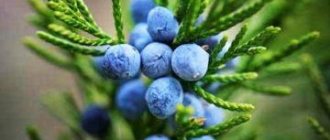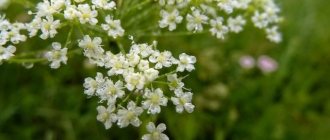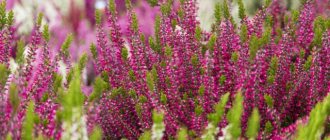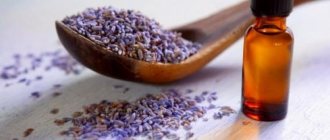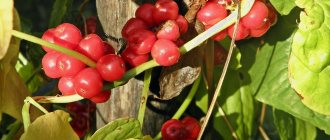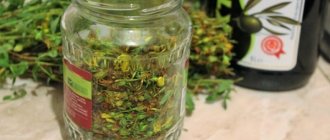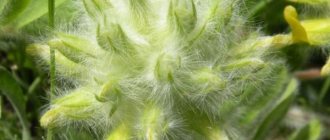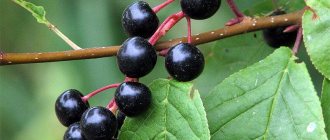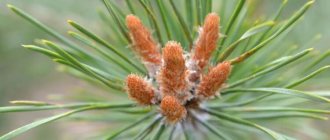Description
The plant is a perennial, coarse-haired species. It has a fibrous, steep and short root. The stem is straight, not branched, hairy. It can reach 80 centimeters in height. At the top of the stem, the medicinal letter does not have leaves; they are concentrated at the roots and collected in a rosette. The stems are oblong-ovate, heart-shaped, slightly pointed. The medicinal letter has quite noticeable leaves. Venation is clearly expressed on the lower, lighter surface. And the upper side is dark and slightly hairy. The plant has an unpleasant and pungent odor that is intoxicating, and a pronounced bitter taste.
The medicinal cap has pubescent and large flowers that are collected in whorls and spike-shaped inflorescences. They have regularly shaped cups and five short, hairy teeth. The corolla is most often painted in a bright red color, much less often in a light, almost white shade. The initial flower blooms in early summer. It has a tetrahedral, oblong, dry, convex fruit. It contains brown, smooth single-seeded nuts that lie at the bottom of the cup. It ripens in early autumn. Most often, the plant reproduces by seeds, rarely by vegetative means.
Contraindications
The initial letter has a lot of positive qualities, but it can do more harm than good if used in the presence of such factors:
- the period of bearing a child and breastfeeding;
- children's age less than 3 years;
- low stomach acidity;
- low pressure;
- high blood clotting rate;
- increased susceptibility to constituent components.
Bukvitsa is not an easy herb; if you exceed the dose, you can be seriously poisoned by it. Medical attention is needed if the following signs are observed:
- blood pressure dropped sharply;
- weakness increases and dizziness occurs;
- vomiting and headache began;
- pulse increased significantly;
- cramps appeared in the legs.
We recommend reading: Lingonberry leaves - methods of use for treatment
In such a situation, you cannot delay calling an ambulance.
Beneficial features
For treatment, the roots of the initial letter and grass are used. The initial drug is distinguished by its pronounced anti-inflammatory, choleretic and expectorant properties. Medicines made from the initial letter have a calming, blood pressure-lowering, and analgesic effect. In addition, it speeds up metabolism, improves digestion and blood circulation. It should be noted that in Russia the medicinal letter is not used in official medicine, but traditional healers use it very successfully.
For epilepsy, nervous excitability, migraines and dizziness, decoctions and teas from the letter are used. Externally, it is used for washing long-term non-healing purulent wounds, ulcers, sinusitis and a runny nose that does not go away for a long time. For asthma and general weakness of the body, the letter has a strengthening effect.
Medicinal letter - used for medical purposes
It was once revered as a medicinal plant and was claimed to cure between 47 and 150 diseases and ailments in any part of the body. However, she slipped from this position into obscurity, even among herbalists. It is not clear whether this is due to a lack of knowledge or because its beneficial effects have simply been overestimated. Today, the initial plant is grown mainly as a decorative fence in gardens.
When working nervously, drink tea or herbal infusion
The traditional use of the medicinal letter is used for:
- low mood;
- increased melancholic character;
- poor liver function;
- circulatory problems;
- joint pain;
- most popular for headaches.
Many people still claim that when taken in tea, it acts as a general tonic and relieves headaches.
The herb has been described and used by Chinese herbalists as a long-term tonic aimed at improving overall health to help the body heal itself. It is not intended to be used as a quick-acting herbal remedy; it works slowly over a long period of time.
This may have contributed to its loss of acceptance in today's world where faster is best.
As a rule, the initial letter is symbolized as a warming and tonic, suitable for improving the general disposition and health of the body. It is known to work well in combination with other herbs such as licorice, ginseng, hawthorn and ashwagandha.
At the moment, the medicinal cap is used in traditional Austrian medicine, internally, as tea, or externally, as compresses or baths, to treat diseases of the respiratory tract, gastrointestinal tract, nervous system, skin and gynecological problems.
Modern herbalists prescribe it to treat anxiety, gallstones, heartburn, migraines and neuralgia, and to prevent sweating. It can also be used as an ointment for cuts and wounds. None of these goals are supported by scientific evidence.
Medicinal initial letter: application
From generation to generation, folk healers pass on the secrets of using this plant, which has astringent and wound-healing properties.
Preparations from its roots are used as an emetic and laxative. A decoction of the roots of the plant is used for appetite disorders, colitis, gastritis, liver and kidney diseases, and nervous diseases.
An infusion, which is prepared on the basis of leaves and roots, treats radiculitis, gout, neuroses and cystitis.
The medicinal herb has found application as a metabolism-normalizing and sedative. The letter has a hemostatic effect, so it stops uterine and pulmonary bleeding.
Preparing medicinal preparations from this herb is not too difficult. We will tell you about some recipes.
Indications for use
Remedies from the plant lower blood pressure, regulate digestive processes well, accelerating peristalsis and enhancing metabolism. The effectiveness of the use of the letter has been clinically proven for whooping cough, bronchitis, bronchial asthma, rhinitis, hyperacid gastritis, gout, pyelonephritis, cystitis, hemorrhoids, migraines, nervous exhaustion, rheumatism, jaundice, epilepsy. Due to its astringent properties, it is taken for severe types of diarrhea, including scurvy.
The rhizomes are used as an emetic and laxative; a decoction of them is recommended to be taken for nervous diseases, general weakness, kidney disease, gastritis, colitis and decreased appetite.
In folk medicine, preparations from the leaves are recommended for the treatment of rheumatism, radiculitis, epilepsy, stroke, bronchitis, cystitis, gout, eye diseases, gynecological disorders and fainting. In addition, the infusion of the leaves has some diuretic effect. Fresh leaves are used in crushed form, applied to ulcerations and non-healing wounds. Dried leaves, ground into powder, are recommended to be snorted as tobacco in case of long-lasting runny nose and headaches of various origins.
The flowers of the capitula officinalis in combination with the leaves are used to treat diarrhea, gynecological pathologies, gout, stroke and fainting.
Herbal infusion
To prepare this composition you will need drop cap herb. Its medicinal use is to use a decoction.
You need:
- 2 tbsp. spoons of grass drop caps;
- 200 ml boiling water.
Pour boiling water over the raw materials and heat over low heat for five minutes. Then you need to let the product brew for half an hour and strain it. After this, 40 grams of port are added to the infusion. Single use - 70 ml three times a day.
Best before date
24 months
Vitamins with similar effects
- Maxiflorum with Valerian (Oral tablets)
- Incas gold. Men's Formula (Oral Tablets)
- Encaps (Capsule)
- Influence (Capsule)
- Set of herbs No. 4 (Oral tablets)
- Narosan Orange (Oral liquid)
- Marine calcium for children with iron (Oral tablets)
- Marine calcium for children with manganese (Oral tablets)
- Pankramin (Powder for oral solution)
- Pantohematogen "Altamar™-1" (Capsule)
Description of the vitamin Grass medicinal cap is intended for informational purposes only. Before starting to use any drug, it is recommended to consult a doctor and read the instructions for use. For more complete information, please refer to the manufacturer's instructions. Do not self-medicate; EUROLAB is not responsible for the consequences caused by the use of information posted on the portal. Any information on the project does not replace consultation with a specialist and cannot be a guarantee of the positive effect of the drug you use. The opinions of EUROLAB portal users may not coincide with the opinions of the site Administration.
Are you interested in vitamin Herb medicinal caps? Do you want to know more detailed information or do you need a doctor's examination? Or do you need an inspection? You can make an appointment with a doctor - the Euro lab is always at your service! The best doctors will examine you, advise you, provide the necessary assistance and make a diagnosis. You can also call a doctor at home . Euro lab clinic is open for you around the clock.
Attention! The information presented in the vitamins and dietary supplements section is intended for informational purposes and should not be a basis for self-medication. Some of the drugs have a number of contraindications. Patients need to consult a specialist!
If you are interested in any other vitamins, vitamin-mineral complexes or dietary supplements, their descriptions and instructions for use, their analogues, information about the composition and form of release, indications for use and side effects, methods of use, dosages and contraindications, notes about the prescription of the drug for children, newborns and pregnant women, price and consumer reviews, or you have any other questions and suggestions - write to us, we will definitely try to help you.
Infusion of flowers and powder for runny nose
Fill a third of the jar (glass) with flowers. Pour vodka to the top of the container. The composition should be stored in a dark place. The product takes two weeks to prepare. The strained composition is used for hypertension, central nervous system disorders, and fainting. Dosage - twenty drops, which must be diluted in a small amount of water.
A powder made from the herb will help with a runny nose. Take the dried leaves of the capitula, grind them into a fine powder and sniff. This is how they once sniffed tobacco, several times a day.
Treatment
Forest herbs are often used in folk medicine, as their effectiveness has been tested for several generations. The medicinal letter is no exception. Stocks of this raw material never hurt; if necessary, you can take the right amount and use “grandmother’s advice” when treating any disease. For medicinal purposes the following is prepared:
| Herb tea | One teaspoon of dry herb is poured into a glass of boiling water and infused for fifteen minutes. Strain the finished tea and use as directed. A maximum of three glasses of the resulting tea can be drunk per day. |
| Leaf infusion | To prepare, you will need a tablespoon of raw materials and a glass of boiling water. You need to insist for two hours. After this, the infusion is filtered and taken two tablespoons four times a day before meals. |
| Root decoction | You need to weigh twenty grams of dry plant roots and pour a glass of water. After this, you need to boil the broth for twenty minutes. You need to take the resulting product one tablespoon three times a day as a laxative. |
| Tincture of flowers | Grind the raw materials, take a glass jar and fill it exactly one third with flowers. Next, you need to pour vodka to the brim. Place the resulting mixture in a dark place for two weeks. Next, you need to strain the tincture. Take twenty drops for high blood pressure, nervous disorders and fainting. If necessary, can be diluted with a small amount of water. |
For nervous disorders
To prepare this composition you will need:
- 2 parts grass drop cap;
- 3 parts thyme;
- 2 parts oregano;
- 1 part Potentilla anserina;
- 1 part woodlice;
- 2 parts hops;
- 2 parts yarrow herb;
- 2 parts sage.
All these herbs are well known. Collecting them will not be difficult. They need to be mixed well. Pour 300 ml of boiling water over a dessert spoon of dry mass. Leave the product to infuse for half an hour and consume 50 ml four times a day. The full course of treatment is twenty-one days, followed by a break of seven days, after which the course can be repeated.
Cooking methods
Infusions and decoctions are made from the initial letter, using foliage, inflorescences and roots for these purposes. These products are suitable for both external and internal use. You just can’t joke with this plant; you must strictly and accurately follow the dosage.
When treating serious diseases, medicinal infusions from medicinal herbs should complement the main treatment prescribed by the doctor, and not replace it.
The duration of treatment with drugs based on the initial letter is no more than 21 days, then a week's rest is required and, if necessary, the course can be repeated.
Leaf infusion
Steam one tablespoon of dry leaves with 250 ml of boiled water and leave covered for a couple of hours.
- You need to drink a large spoonful of the infusion 4 times a day to lower your blood pressure, get rid of a cough and calm your nerves.
- If you are suffering from sinusitis, it will help a lot if you drop a whole pipette of the decoction into your nose at least 5 times a day. This will clear your sinuses well.
- For diseases of the gastrointestinal tract, taking a large spoonful of the decoction at least four times a day before meals will help.
- Gargling with a decoction will relieve sore throat and inflammation of the mouth or gums.
- Having evaporated the decoction to half the volume, you can use it to treat festering ulcers and difficult-to-heal wounds.
- If you add honey to this decoction and drink a quarter glass 4 times a day, then this is an excellent expectorant for diseases of the bronchopulmonary system.
Boil a couple of spoons of the leaves of the initial cap for 5 minutes in 250 ml of water after boiling. Leave for a couple of hours and add two spoons of port.
The decoction will restore blood if you drink a couple of large spoons of it four times a day. You can cleanse the blood and strengthen blood vessels if you take the product in the morning, at lunch and in the evening, a spoonful.
Herbal infusion
Pour 20 g of herb into a liter of boiled water and leave for two hours.
Half an hour before meals, drink 50 ml of infusion in the morning, afternoon and evening.
With this remedy you can get rid of asthma, whooping cough and cure cough.
Steam 20 g of raw materials with 2 liters of boiled water. Pour the infusion into a wide container and steam your feet in it until it cools down for 14 days every evening. This is good for eliminating excessive sweating.
Gynecological diseases and bleeding from the uterus can be treated with alcohol tincture of the letter. Pour 100 g of herb into 200 ml of vodka and leave for a week. 1 tsp. Mix the tinctures with three large spoons of water and drink. Repeat morning and evening.
Root decoction
Boil 50 g of plant roots for about five minutes after boiling in two glasses of water. Cool and filter. Drink 150 ml of decoction in the morning, afternoon and evening to stop diarrhea.
We recommend reading: Horsetail: benefits and harms, use in folk medicine
But a decoction prepared in this way will relieve constipation. Boil 30 g of crushed rhizome for 20 minutes in 250 ml of water. Take a large spoon three times a day.
Boil a tablespoon of crushed roots of the capitula for about half an hour in 500 ml of milk. Leave for a couple of hours. After straining, take 50 ml before meals in the morning, afternoon and evening for 21 days to treat gout, radiculitis, pathologies of the stomach, liver and kidneys. It is also suitable for prolonged stress, poor appetite and loss of strength.
Hepatitis is treated according to a different scheme. For 14 days, drink a third of a glass of the infusion before breakfast, lunch and dinner.
Infusion of leaves and rhizomes
If you combine the roots and leaves in an infusion, then this remedy treats allergies, the heart and blood vessels, the digestive, genitourinary and biliary systems.
Steam 15 g of roots and leaves with 250 ml of boiled water and leave for a couple of hours. Filter well and take a large spoon twice before lunch and twice in the evening.
Infusion of flowers
Take a 0.5 liter jar and fill about a third with flowers. Pour a bottle of vodka into the jar. Place in a dark place to infuse for 14 days. In the morning and evening, drink 20 drops, diluting them in 50 ml of water.
This tincture is used as a sedative for nervous system disorders. Relieves nervous tension, eliminates depressive syndrome and gently lowers blood pressure.
Where else is the drop cap used?
- The powder of this plant dyes wool yarn brown-olive and grayish-red.
- In furriery, the plant's tannins are used to tan leather.
- The aerial part of the plant is used as a flavoring agent in the alcoholic beverage industry.
- Printers used to cut out light and durable letters and letters from the wood of initial letters.
- Used as feed for small livestock.
- The plant is decorative, therefore it is used to decorate lawns.
Medicinal and beneficial properties of the medicinal letter
All the healing properties of the perennial medicinal plant are due to the chemical composition, which is represented by:
- flavone glycosides or flavonoids, the amount of which does not exceed 1.54%;
- essential oils or etherols, in an amount not exceeding 0.83%;
- alkaloids in the form of stachydrine and choline, in the range of 2.0-2.42%;
- resinous substances in a volume of up to 5.72%;
- vitamins “C” and “K”;
- tannins in an amount not exceeding 5.0%;
- carbonates.
Due to the presence of a large number of useful components, the drop cap is used in the treatment and prevention of many pathologies, and also has a number of useful properties, including:
- strengthening the immune system;
- normalization of the circulatory system;
- normalization of metabolic processes in the body;
- improvement of blood clotting processes;
- stabilization of blood pressure indicators;
- accelerating the healing of damage to the skin and mucous membranes;
- disinfection of wounds and abrasions;
- improving the performance of the digestive organs.
Plant raw materials have a very pronounced analgesic effect, and also have an expectorant and choleretic effect.
Procurement of raw materials
The collection of raw materials is carried out on a dry and clear day, after the dew has dried. When harvesting, 10% of the plants should be left so that they can produce seeds for further propagation.
The grass is not packed tightly into the bags. Before drying, it is necessary to remove all yellowed leaves and parts of the plant damaged by insects. Dry the grass in a well-ventilated and slightly darkened room, tying it into loose bunches. You can spread it in a thin layer, in the shade in the air or in a dryer (temperature 40–50 °C). Once dried, the plants should become brittle. Dry herb capitula should have a weak aroma and a bitter taste. The shelf life of raw materials is two years. The roots have a longer shelf life - three years.
What is included in the medicinal letter
The letter contains bitter and tannins (stahydrine, choline, betonicine), alkaloids (0.1-0.5%), mucus and essential oil (up to 0.058%).
Initial seeds contain fatty oil (up to 42%) and an enzyme that breaks down fats. The leaves of the initial cap contain 12.46%, and the flowers – up to 7.07% tanids, which are partially used for tanning hides.
Pharmacological properties
For medicinal purposes, the roots, rhizomes and grass of the capitula are used. The plant has expectorant, anti-inflammatory, and choleretic properties.
Preparations based on the initial letter have an analgesic, sedative, and blood pressure-reducing effect. The letter stabilizes digestion, normalizes metabolism in the body, and improves blood circulation.

